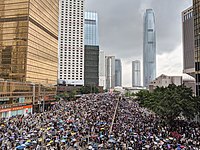
Photo from wikipedia
ABSTRACT In this article, I argue that embodied forms of identity, politics and protests have become critical to South Asian social movements because actors have started identifying ways in which… Click to show full abstract
ABSTRACT In this article, I argue that embodied forms of identity, politics and protests have become critical to South Asian social movements because actors have started identifying ways in which society uses their bodies to oppress them. The fact that “embodied” form of resistance is the prevalent theme of countless contemporary movements like Girls at Dhaba in Pakistan, Women’s March against President Donald Trump in the USA, “Pinjra Tod” in India, etc., proves that it is increasingly becoming urgent to study the way the female body can resist domination and oppressive structures. Discussing the definition of “embodied” resistance, and the gendered idea of “safety” and “peril” in urban spaces, I examine the ways in which recent protest movements such as Pinjra Tod (Break the Cages) in Delhi use embodied forms of politics and identity to subvert the norms that chain and restrict the female body.
Journal Title: Asian Journal of Women's Studies
Year Published: 2019
Link to full text (if available)
Share on Social Media: Sign Up to like & get
recommendations!